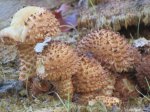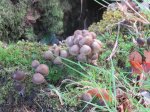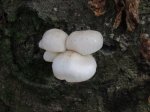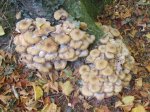The Ultimate "What is this Fungi?" thread.
- Thread starter Crafty
- Start date
-
Come along to the amazing Summer Moot (21st July - 2nd August), a festival of bushcrafting and camping in a beautiful woodland PLEASE CLICK HERE for more information.
You are using an out of date browser. It may not display this or other websites correctly.
You should upgrade or use an alternative browser.
You should upgrade or use an alternative browser.
To a complete fungi novice is there a consensus on publications to start with or any particular rules to follow on distinguishing if edible or not? Similar to if an animal is brightly colored then probably poisonous
The short answer to your question is no - there are no 'general' rules and especially not 'animals/insects eat it, it should be OK' or 'if it smells like this' or is 'this or that colour' - just not that simple I'm afraid.
I have a lot of books but the two I currently use are Mushrooms, Roger Philips, published by Macmillan (the book used by mycologists) and, after recommendations on this forum, Edible Mushrooms, Geoff Dann, published by Green Books. Both have limitations and occasionally the photos don't look the same in the two books so be prepared to use other references to be 100% safe. If you stick to a few easily identified ones first then gradually extend your knowledge you should be fine.
Thanks Broch and is as feared / suspected, I like the idea of cross referencing tho, makes sense to me. I just want to be able to identify a couple of edibles that I may find as I bimble, in a similar way as I would coming across brambles and berries. In a way to not be supermarket reliant if that makes sense rather than be a ‘master forager’
Cheers
Cheers
Hi,
I was wondering if anyone could help a fungi newbie with this.
I was thinking chanterelle?
I found it in a crosican/Scots pine plantation growing underneath a rhodedendran.
Any help much appreciated!



Sent from my CLT-L09 using Tapatalk
I was wondering if anyone could help a fungi newbie with this.
I was thinking chanterelle?
I found it in a crosican/Scots pine plantation growing underneath a rhodedendran.
Any help much appreciated!



Sent from my CLT-L09 using Tapatalk
Hi,
I was wondering if anyone could help a fungi newbie with this.
I was thinking chanterelle?
I found it in a crosican/Scots pine plantation growing underneath a rhodedendran.
Any help much appreciated!
Sent from my CLT-L09 using Tapatalk
I suggest False Chanterelle as it's growing on the pine cone (it is isn't it?) it can cause hallucinations so I'd avoid.
It is! I found 3 growing like this directly out of the pine cones which I thought was pretty cool.I suggest False Chanterelle as it's growing on the pine cone (it is isn't it?) it can cause hallucinations so I'd avoid.
I think I agree! After reading it seems the gills and lack of a 'fruity' smell suggest it's a false chanterelle.
Hopefully be back in the same spot next week to finish a job so I'm going to check whether the stem is hollow or not.
Thanks for the advice, appreciate the help
Sent from my CLT-L09 using Tapatalk
To a complete fungi novice is there a consensus on publications to start with or any particular rules to follow on distinguishing if edible or not? Similar to if an animal is brightly colored then probably poisonous
If it is foraging you're interested in, then my book is by far the most comprehensive published in the UK (see reviews):
https://www.amazon.co.uk/Edible-Mushrooms-Foragers-Britain-Europe/dp/0857843974
Signed copies available direct from the author...
I suggest False Chanterelle as it's growing on the pine cone (it is isn't it?) it can cause hallucinations so I'd avoid.
That's a mistake in Phillips. There are no records of it actually causing hallucinations, just mild stomach upsets.
That's a mistake in Phillips. There are no records of it actually causing hallucinations, just mild stomach upsets.
Yes, I've since read elsewhere that it is often quoted but without proof and doubted by many. Not an easy subject is it?
These? On long slender stalks like the Parasols.
I must get a copy of your book Geoff.

Stalks much thinner than parasols. Those are rooting shanks.
I’m after the collective expertise on here for some advice. We’ve had these pop up through the gravel in the yard at work. I think they’re probably common earthball but they don’t seem to exactly match the images I’ve found (if you can’t tell I’m very much a novice when it comes to fungi ID). I’m fairly certain they’re inedible but I’m interested to know what they are 
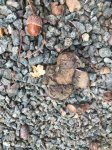
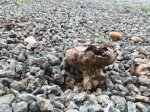
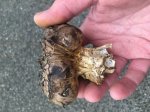
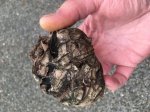
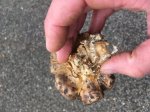





I thought that was a possibility when I first found them but again they don’t quite seem to match the images I’ve found. In addition I get the impression dyeball are a tad rare but some years we get masses of these locally.
First one is probably spiny puffball. Found in deciduous woodland mostly below beech. Latin name lycoperdon echinatum acording to my book
I’m after the collective expertise on here for some advice. We’ve had these pop up through the gravel in the yard at work. I think they’re probably common earthball but they don’t seem to exactly match the images I’ve found (if you can’t tell I’m very much a novice when it comes to fungi ID). I’m fairly certain they’re inedible but I’m interested to know what they are
View attachment 50690 View attachment 50691 View attachment 50692 View attachment 50693 View attachment 50694
This could be a stratus hygrometricus. Puffball family. Astratus=star do they seem to open out with star like "legs"when wet. It does say rare north of the alps in my book.
First one is probably spiny puffball. Found in deciduous woodland mostly below beech. Latin name lycoperdon echinatum acording to my book
I thought it may have been a Shaggy Parasol
Similar threads
- Replies
- 1
- Views
- 219
- Replies
- 0
- Views
- 433
- Replies
- 0
- Views
- 534
- Replies
- 1
- Views
- 736
- Replies
- 261
- Views
- 19K

